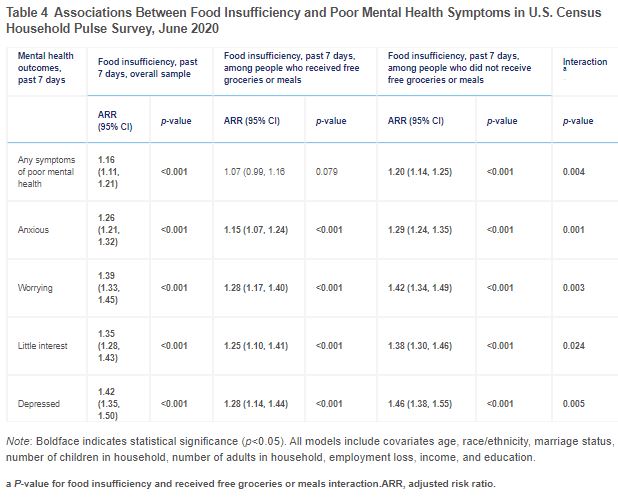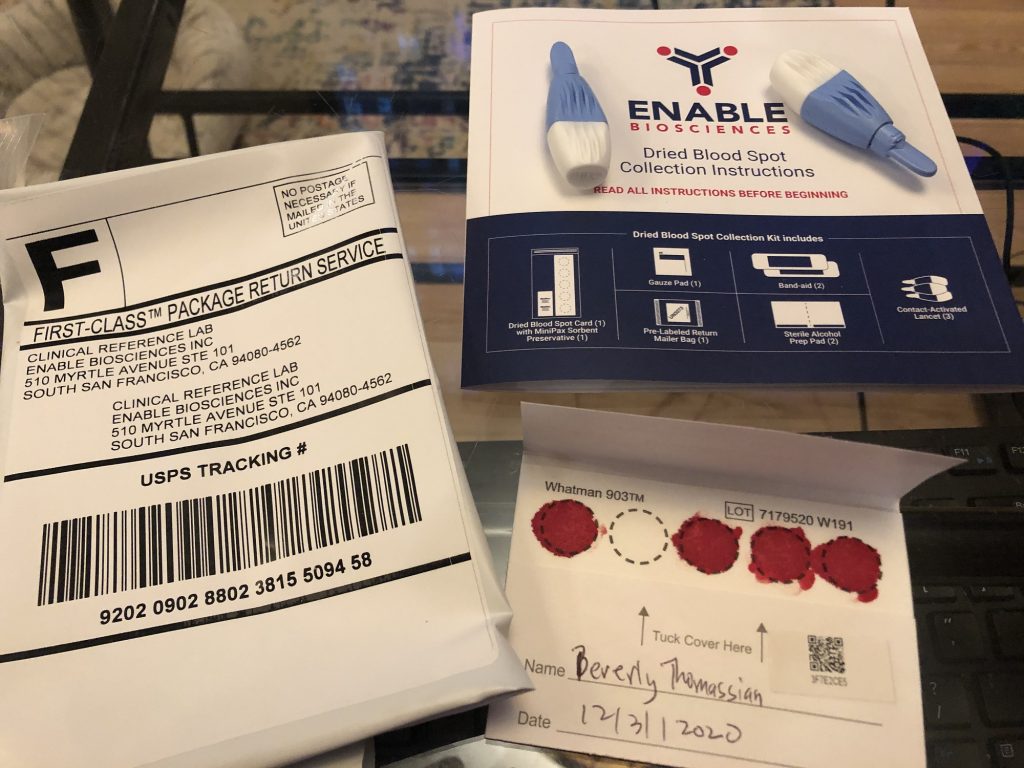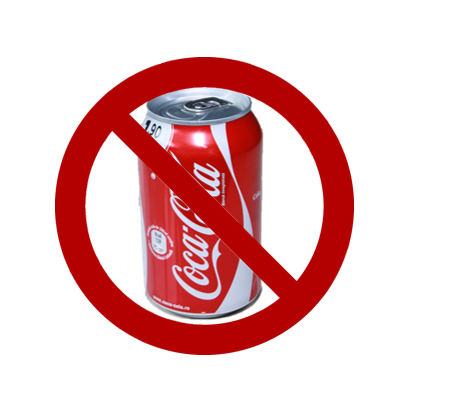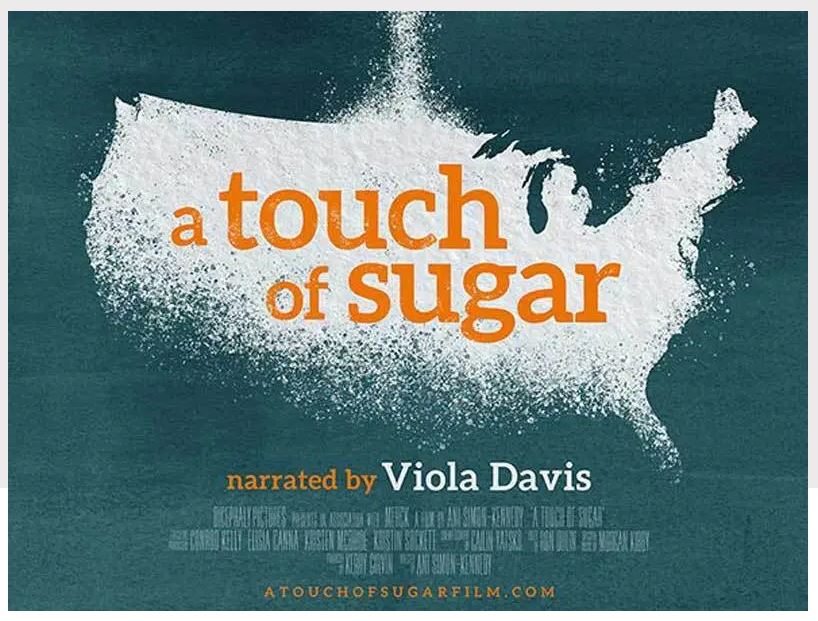Food Insecurity, COVID, & Mental Wellness

Not having our basic needs met, like limited access to food, has a dramatic impact on our mental health.
The pandemic has significantly impacted our mental health due to the trauma, social isolation, and economic instability which has led to an increase in food insecurity.
Since the start of the pandemic, the number of families experiencing food insecurity has increased dramatically, from 8.1% to 10.0% from March to June 2020.
As Diabetes Care & Education Specialists, we realize how important access to healthy, nutritious foods are for diabetes self-care and mental health. Addressing food insecurity and providing resources to fill in gaps, can be a lifeline and improve mental health for people living with diabetes.
A recent study led by Jason M. Nagata, MD, MSc, who works in the Division of Adolescent and Young Adult Medicine, Department of Pediatrics, at UCSF dove into the correlation between food insecurity and mental health.
“Food insecurity is associated with diets high in low-cost, energy-dense packaged foods, but low in fruits and vegetables, which may lead to chronic medical conditions such as diabetes and hypertension, both of which are known to be associated with a higher risk for severe COVID-19 illness” the study states.
The study highlights how different populations are more at risk of experiencing food insecurity with lower-income, single individuals or large families, people of color, those recently unemployed, and people younger in age being the most affected.
Food access disparities that disproportionately affect people of color and low-income individuals and families have been an ongoing public health concern, even before the pandemic.
The study by Dr. Nagata and team cites the term “food apartheid” which activist Dara Cooper describes as the “blatantly discriminatory corporate-controlled food system that results in [communities of color] suffering from some of the highest rates of heart disease and diabetes of all time.”
Food shortages due to border closures, essential workers falling ill, school closures that provided meals to over 35 million children pre-pandemic, and the overall economic crisis, have exasperated food insecurity.
“Food insecurity may lead to poor mental health through chronic stress, stigmatization, and perceived powerlessness. Conversely, people experiencing poor mental health symptoms may be less able to work, generate income, or manage financial resources, which could exacerbate food insecurity.”
The study used cross-sectional data from the U.S. Census Household Pulse Survey that was collected and analyzed in 2020 across 63,674 participants. Those who experienced food insufficiency in the past 7 days were more likely to experience mental health outcomes such as anxiety, worry, anhedonia, and depression.

A decrease in mental health symptoms was noted for those who received free groceries within the past 7 days.
The study concludes that assistance programs that provide free meals, financial assistance, paid sick leave, mental health resources, and stimulus funding can help decrease the cycle of food insecurity and improve mental health outcomes.
To read more, click here to view the study.
Click here to read more about food apartheid.
Written by Bryanna, our Director of Operations & Customer Happiness
More Resources for Health Care Providers
The National CLAS Standards website (https://thinkculturalhealth.hhs.gov) offers a number of resources and materials that can be used to improve the quality of care delivery to non–English-speaking patients
The ADA provides a list of mental health providers who have received additional education in diabetes at the ADA Mental Health Provider Directory (professional.diabetes.org/mhp_listing).
Join Coach Beverly for her annual- Recorded and Ready for Viewing
Level 2 – Standards of Care Update!
This course is an essential review for anyone in the field of diabetes. This course summarizes the 2021 updates to the American Diabetes Association’s Standards of Medical Care in Diabetes and provides critical teaching points and content for health care professionals involved in diabetes care and education.
Earn 2.0 CEs and get ready to lead the charge to implement best care practices for the New Year.
Topics Include:
- A review of changes and updates to the 2021 ADA Standards of Medical Care
- Identification of key elements of the position statement
- Discussion of how diabetes educators can apply this information in their clinical setting
Sign up for Diabetes Blog Bytes – we post one daily Blog Byte from Monday to Friday. And of course, Tuesday is our Question of the Week. It’s Informative and FREE! Sign up below!
[yikes-mailchimp form=”1″]
Accreditation: Diabetes Education Services is an approved provider by the California Board of Registered Nursing, Provider 12640, and Commission on Dietetic Registration (CDR), Provider DI002. Since these programs are approved by the CDR it satisfies the CE requirements for the CDCES regardless of your profession.*
The use of DES products does not guarantee the successful passage of the CDCES exam. CBDCE does not endorse any preparatory or review materials for the CDCES exam, except for those published by CBDCE.
At-Home Test for Type 1 Diabetes

Rates of Type 1 Diabetes is on the Rise
The rates of new type 1 diabetes are increasing, especially among Black and Hispanic youth. Many people don’t develop the disease until later in life — and upwards of 85% of people with T1D have no family history of the disease. A new at-home test will be available for everyone who is interested in seeing if they have antibodies that indicate an immune mediated diabetes.
Signs of Type 1 Diabetes
- Excessive thirst
- Frequent urination
- Unexplained weight loss
- Exhaustion
- New bedwetting (especially at night)
For many families, the symptoms of type 1 diabetes come out of the blue and can be missed or attributed to other illnesses. This lack of awareness can delay life-saving treatment for type 1 diabetes.
The Juvenile Diabetes Resource Foundation (JDRF) in collaboration with Enable Bioscience has developed an at-home test so families can detect if there are antibodies for type 1. This test includes measurement of GAD, ICA and IAA2. The test is easy, simple, and can help save lives.
Diabetes runs in my family, so I did the test
Since immune-mediated diabetes runs in my family, I excitedly ordered my test kit. The instructions were easy to follow and everything I needed to ship my test card back to the lab was included. In addition, they sent an email confirming receipt of my info. Now I am just waiting for the results.

There is hope that insurance companies will cover this test in the future. But for now, the test costs a little under $60 and there is an option to request financial assistance if needed.
To raise awareness, when you order your testing kit for type 1, participants also receive a box of handbills, posters, bracelets, and other information to get the word out about signs of type 1 diabetes.

JDRF has taken a leadership role in helping to prevent and cure type 1 diabetes. Making a home blood test available to everyone is a promising step towards that.
Because T1D starts long before insulin is required, families will be able to prepare, develop a plan for further monitoring with their doctor and hopefully avoid seriously and sometimes life-threatening conditions, such as diabetic ketoacidosis (DKA), along with possible hospitalization. (JDRF)
Hope for the future
I am hopeful that there will be an effective treatment to stop the progression of Type 1 diabetes during my lifetime. Scientists and JDRF-funded research are closer than ever to developing therapies that can intervene and disrupt type 1’s disease’s progress before insulin therapy is needed.
To get your testing kit or to learn more about the work JDRF is doing, please click here for more info.

Sign up for Diabetes Blog Bytes – we post one daily Blog Byte from Monday to Friday. And of course, Tuesday is our Question of the Week. It’s Informative and FREE! Sign up below!
[yikes-mailchimp form=”1″]Accreditation: Diabetes Education Services is an approved provider by the California Board of Registered Nursing, Provider 12640, and Commission on Dietetic Registration (CDR), Provider DI002. Since these programs are approved by the CDR it satisfies the CE requirements for the CDCES regardless of your profession.*
The use of DES products does not guarantee the successful passage of the CDCES exam. CBDCE does not endorse any preparatory or review materials for the CDCES exam, except for those published by CBDCE.
Most People with Diabetes Have Fatty Liver Disease
Hugo Rosen, MD, a liver disease specialist and chair at the Keck School of Medicine of USC, has witnessed a startling shift in his practice. There are less individuals coming in for hepatitis C and a lot more people seeking treatment for fatty liver disease.

It is estimated that a quarter of the global population has nonalcoholic fatty liver disease (NAFLD). Results from a Mayo Clinic study and other studies suggests NAFLD is linked to increased risk of liver cancer, and susceptibility to other forms of cancer.
60% of people with type 2 diabetes also have nonalcoholic fatty liver disease. NAFLD is often considered as a manifestation of the metabolic syndrome, especially in those with elevated BMIs and diabetes.
Dr. Rosen says he’s most worried about fad diets like Keto that are attractive to people because they can eat lots of tasty foods like butter, cheese, and red meat, but it encourages a high increase in fat. Rosen says 80% of your calories will generally come from fat on the keto diet.
Studies on mice suggest the uptake in fat in the diet can lead to nonalcoholic fatty liver disease. The hardest part about NAFLD is that most people don’t know they have it and don’t start exhibiting signs of it until it has progressed to cirrhosis or nonalcoholic steatohepatitis (NASH).
What action can people take?
The current recommended treatment includes weight loss (because it helps reduce fat and inflammation in the liver) and eating a well-balanced diet with fiber, and lessening fat intake particularly from processed foods.
Don’t overdo it on fats, Rosen recommends, especially from processed foods. Fructose and other sugars are a major concern as well, especially in sodas, candy, sugary cereals, sweetened juices and fast food. Those kinds of refined foods can increase cholesterol and cause inflammation in the liver.
Vitamin E and Pioglitazone have helped some with NAFLD, but results are inconsistent and there is no FDA-approved drug to specifically treat it yet.
For the full study details and nutrition and lifestyle recommendations for NAFLD, see USC’s article on Rosen here.

Want to learn more?
Join us in January for a full update of Level 1 Diabetes Fundamental courses! Coach Bev will be updating all of Level 1 live throughout this month. See full course schedule here.
Can’t make it live? No problem:
All our courses are recorded and are available for viewing in your online university account. Don’t miss these crucial 2020 updates:
Sign up for Diabetes Blog Bytes – we post one daily Blog Byte from Monday to Friday. And of course, Tuesday is our Question of the Week. It’s Informative and FREE! Sign up below!
[yikes-mailchimp form=”1″]Warning – Common Household Chemicals Associated with Excess Weight and Osteoporosis
Experts are meeting with congress to encourage investigation of the relationship of human exposure to perfluoroakyl and polyperfluoroakyl (PFAS) on weight and osteoporosis.
Early studies have shown a link between greater PFAS exposure and increased risk for endocrine outcomes like BMI >30, but more research is needed specifically to examine factors like exposure timing,” Abby Fleisch, MD, MPH
Read More here – Endocrine Today Article

These commonly found chemical PFA substances are endocrine disrupting chemicals and may be the driving factor responsible for a variety of adverse health outcomes.
PFAS are a large and expanding group of man-made compounds that are widely used to make everyday products more resistant to stains, grease and water, according to the NIH.
PFAS can be found in nonstick cookware, stain-resistant carpeting, to-go containers, cleaning products, drinking water, microwave popcorn, and even fire extinguisher foam. Toxic Free Future advises avoiding common packaged foods with grease repellent coatings (such as pizza and french fry boxes), avoid stain resistance treatments on furniture, and check personal care products for teflon, “fluoro” or “perfluoro.”
Toxic Free Future has created a fantastic educational flyer on PFAS, it’s sources, and easy alternatives:

For more tips on minimizing exposure to PFAS and what can be done about PFAS, you can visit Toxic Free Future’s website here. We also discuss PFAs in our recent FREE Webinar, Getting to the Gut. Click below to get started.
Sign up for Diabetes Blog Bytes – we post one daily Blog Byte from Monday to Friday. And of course, Tuesday is our Question of the Week. It’s Informative and FREE! Sign up below!
[yikes-mailchimp form=”1″]Sugar Sweetened Beverages: Out of Sight and out of Mind

In a study conducted by University of California San Francisco’s (UCSF) Elissa Epel and colleagues, Epel wanted to evaluate the relationship between access to sugar-sweetened beverages (SSB) in the workplace and total daily consumption.
Epel and team banned the sale of all SSBs at UCSF for 10 months. Her team found that in employees deemed “frequent” SSB drinkers, consumption went down from 35 fluid ounces to a startling 17 oz.
Even though the employees still had access to SSBs outside of the campus, their consumption decreased significantly, highlighting the impact of eliminating access to SSBs in the work environment.
“This shows us that simply ending sales of sugary drinks in the workplace can have a meaningful effect on improving health in less than one year,” Epel said in a statement. “There is a well-known pathway from soda to disease. High sugar intake leads to abdominal fat and insulin resistance, which are known risk factors for diabetes, heart disease, cancer and even dementia. Recent studies have also linked sugar intake to early mortality.”
But this correlation was not enough for Epel. Before the ban went into effect, her team recruited 214 full-time employees who were self-reported “frequent” SSB drinkers. Epel and her team then randomly separated the employees into two groups: one group would receive a motivational intervention along with the SSB ban, while the other group wouldn’t receive any intervention. The motivational intervention included a 15-minute motivational session to begin and 5-minute calls one week, one month, and sixth months after the ban was put into effect.
The results were astounding; the participants in the intervention group consumed 25.4 oz less compared to the control group who only consumed 8.2 oz less.
Epel and her team had successfully proven a correlation between banning SSBs and consumption as well as a correlation between intervention and consumption. To read more about Epel’s study click here.
Sign up for Diabetes Blog Bytes – we post one daily Blog Byte from Monday to Friday. And of course, Tuesday is our Question of the Week. It’s Informative and FREE! Sign up below!
[yikes-mailchimp form=”1″]Flu Shot Song – Just in Time for Flu Season
Flu season is upon us! People with diabetes (type 1, type 2, or gestational), even when well-managed, are at high risk of serious flu complications, which can result in hospitalization and sometimes even death.
Many people are reluctant to get the flu shot. Help move them out of pre-contemplation to action with this informative and upbeat instructional video and song!

Is an educational and entertaining method to bring to light information about the Flu and the Flu Shot…through music!
“The Flu Shot Song” by Nurse Master Charlie, provides a general overview and the science behind why the flu vaccine works to prevent the flu; All while using the universal language of music!!!
This upbeat and informational video describes a quick history, along with transmission methods, differentiation, symptoms, prevention, diagnosis and treatment of the flu.
Flu Vaccines for People with Diabetes
- Injectable influenza vaccines (flu shots) are recommended for use in people with diabetes. The flu shot has a long, established safety record in people with diabetes.
- The live attenuated influenza vaccine (LAIV), also known as the nasal spray vaccine, is recommended as an option for use in people 2 through 49 years of age who are not pregnant. But, people with some chronic medical conditions (such as diabetes) should generally not receive LAIV.
- See the CDC Webpage for more info.
Nurse Master Charlie pictured at the CA AADE Meeting
Contact or follow Nurse Master Charlie
Instagram: Nurse Master Charlie
Facebook: Nurse Master Charlie
YouTube: Nurse Master Charlie
Twitter: Nurse Master Charlie
Email: [email protected]
Sign up for Diabetes Blog Bytes – we post one daily Blog Byte from Monday to Friday. And of course, Tuesday is our Question of the Week. It’s Informative and FREE! Sign up below!
[yikes-mailchimp form=”1″]
Changing your diet may lower depression
A new trial conducted by researchers at Macquarie University found a strong association between poor diet and depression. To conduct this trial, researchers split participants into two groups: one group ate a Mediterranean-style diet while the other control group continued to eat their usual diet.

They found that in the group that had changed their diet to eat healthier, depression levels decreased from moderate to non-depressed. The other group remained in the moderately depressed severity range.
“Highly processed foods increase inflammation,” researcher Heather Francis, a lecturer in clinical neuropsychology at Macquarie University in Sydney, Australia, told NPR via email. What’s more, “if we don’t consume enough nutrient-dense foods, then this can lead to insufficiencies in nutrients, which also increases inflammation,” she said.
The “healthy group” ate around six more servings of fruits and vegetables than the control group. They were also told to increase their intake of whole grains and healthy proteins and avoid processed foods.
NPR noted that this trial was not a stand alone. In 2017, one study found a link between eating a diet full of refined grains, red meat, and high-fat dairy products and depression.
Although there may be other factors affecting this data, such as the fact that there is no way to “blind” the participants (hence there’s the potential for placebo), this trial could be the first step to lower levels of depression. What this trial truly highlights is how much of one’s life can be affected by the food choices they make.
Read more on this study here.
Sign up for Diabetes Blog Bytes – we post one daily Blog Byte from Monday to Friday. And of course, Tuesday is our Question of the Week. It’s Informative and FREE! Sign up below!
[yikes-mailchimp form=”1″]
Free Resource Friday | A Touch of Sugar Documentary
A Touch of Sugar, a documentary on type 2 diabetes, debuted at the 2019 Tribeca Film Festival. This documentary highlights the experiences of people with type 2 diabetes.

In particular, the film focuses on stories from African-American and Latino communities, both of which are disproportionately affected by type 2 diabetes. Narrated by Viola Davis and created in collaboration with Merck as a part of its larger campaign, America’s Diabetes Challenge, the documentary urges people to think about how we can address the stigma associated with diabetes.
Watch the documentary on FYI Television Network:
Saturday, 11/23 at 10:30 a.m EST
Monday, 11/25 at 8:30 a.m. EST
Visit America’s Diabetes Challenge to learn more about the film!
Sign up for Diabetes Blog Bytes – we post one daily Blog Byte from Monday to Friday. And of course, Tuesday is our Question of the Week. It’s Informative and FREE! Sign up below!
[yikes-mailchimp form=”1″]








